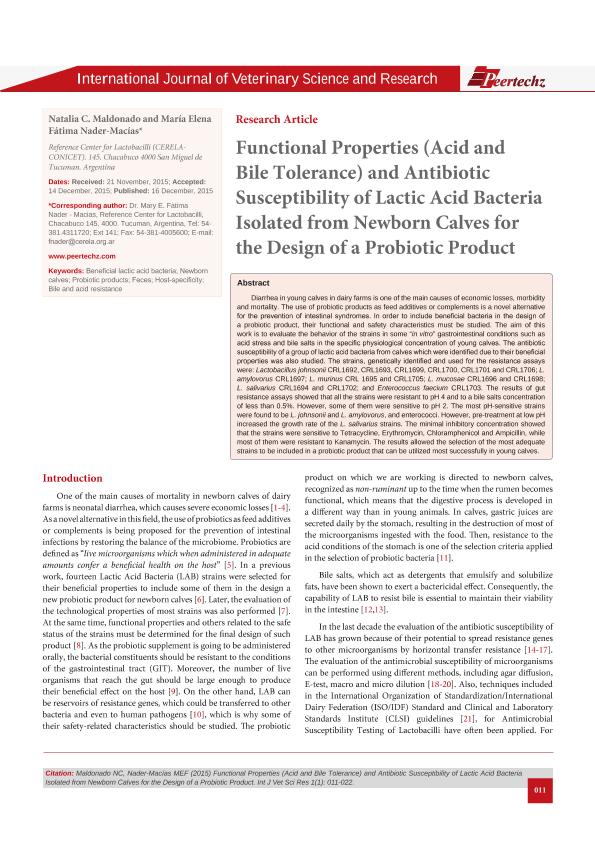Mostrar el registro sencillo del ítem
dc.contributor.author
Maldonado, Natalia Cecilia

dc.contributor.author
Nader, Maria Elena Fatima

dc.date.available
2017-11-22T15:01:14Z
dc.date.issued
2015-12
dc.identifier.citation
Maldonado, Natalia Cecilia; Nader, Maria Elena Fatima; Functional Properties (acid and bile tolerance) and antibiotic susceptibility of lactic acid bacteria isolated from newborn calves for the design of a probiotic product; Park Publishing group; International Journal of Veterinary Science and Research; 1; 1; 12-2015; 011-022
dc.identifier.issn
2410-9444
dc.identifier.uri
http://hdl.handle.net/11336/28722
dc.description.abstract
Diarrhea in young calves in dairy farms is one of the main causes of economic losses, morbidity and mortality. The use of probiotic products as feed additives or complements is a novel alternative for the prevention of intestinal syndromes. In order to include beneficial bacteria in the design ofa probiotic product, their functional and safety characteristics must be studied. The aim of this work is to evaluate the behavior of the strains in some ?in vitro? gastrointestinal conditions such as acid stress and bile salts in the specific physiological concentration of young calves. The antibioticsusceptibility of a group of lactic acid bacteria from calves which were identified due to their beneficial properties was also studied. The strains, genetically identified and used for the resistance assays were: Lactobacillus johnsonii CRL1692, CRL1693, CRL1699, CRL1700, CRL1701 and CRL1706; L.amylovorus CRL1697; L. murinus CRL 1695 and CRL1705; L. mucosae CRL1696 and CRL1698; L. salivarius CRL1694 and CRL1702; and Enterococcus faecium CRL1703. The results of gut resistance assays showed that all the strains were resistant to pH 4 and to a bile salts concentration of less than 0.5%. However, some of them were sensitive to pH 2. The most pH-sensitive strains were found to be L. johnsonii and L. amylovorus, and enterococci. However, pre-treatment at low pHincreased the growth rate of the L. salivarius strains. The minimal inhibitory concentration showed that the strains were sensitive to Tetracycline, Erythromycin, Chloramphenicol and Ampicillin, while most of them were resistant to Kanamycin. The results allowed the selection of the most adequate strains to be included in a probiotic product that can be utilized most successfully in young calves.
dc.format
application/pdf
dc.language.iso
eng
dc.publisher
Park Publishing group
dc.rights
info:eu-repo/semantics/openAccess
dc.rights.uri
https://creativecommons.org/licenses/by-nc-sa/2.5/ar/
dc.subject
Beneficial Lactic Acid Bacteria
dc.subject
Newborn Calves
dc.subject
Probiotic Products
dc.subject
Feces
dc.subject
Host Specificity
dc.subject
Bile And Acid Tolerance
dc.subject.classification
Otras Producción Animal y Lechería

dc.subject.classification
Producción Animal y Lechería

dc.subject.classification
CIENCIAS AGRÍCOLAS

dc.title
Functional Properties (acid and bile tolerance) and antibiotic susceptibility of lactic acid bacteria isolated from newborn calves for the design of a probiotic product
dc.type
info:eu-repo/semantics/article
dc.type
info:ar-repo/semantics/artículo
dc.type
info:eu-repo/semantics/publishedVersion
dc.date.updated
2017-09-13T16:21:19Z
dc.identifier.eissn
2413-8444
dc.journal.volume
1
dc.journal.number
1
dc.journal.pagination
011-022
dc.journal.pais
Pakistán

dc.journal.ciudad
Bahin
dc.description.fil
Fil: Maldonado, Natalia Cecilia. Consejo Nacional de Investigaciones Científicas y Técnicas. Centro Científico Tecnológico Conicet - Tucumán. Centro de Referencia para Lactobacilos; Argentina
dc.description.fil
Fil: Nader, Maria Elena Fatima. Consejo Nacional de Investigaciones Científicas y Técnicas. Centro Científico Tecnológico Conicet - Tucumán. Centro de Referencia para Lactobacilos; Argentina
dc.journal.title
International Journal of Veterinary Science and Research
dc.relation.alternativeid
info:eu-repo/semantics/altIdentifier/url/https://www.peertechz.com/Veterinary-Science-Research/pdf/IJVSR-1-104.pdf
Archivos asociados
